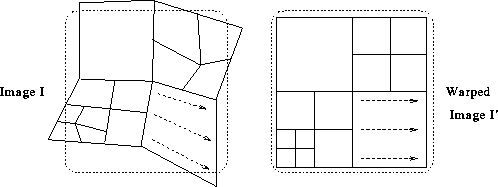


Next: Octree Subdivision
Up: Performance and Optimization
Previous: Performance and Optimization

Figure 4: 2D analogue of piecewise linear warping. A warped image
 is first subdivided by an adaptive grid of squares, here
marked by solid lines. Then, each square vertex is warped into
is first subdivided by an adaptive grid of squares, here
marked by solid lines. Then, each square vertex is warped into
 . Finally, pixels in the interior of each grid cell are
warped by bilinearly interpolating the warped positions of the
vertices. The dashed arrows demonstrate how the interior of the bottom
right square is warped. The dotted rectangles mark image buffer
borders.
. Finally, pixels in the interior of each grid cell are
warped by bilinearly interpolating the warped positions of the
vertices. The dashed arrows demonstrate how the interior of the bottom
right square is warped. The dotted rectangles mark image buffer
borders.
The 2D form of this optimization, shown in figure 4,
illustrates its key steps within the familiar framework of image
warping. In 3D, piecewise linear warping begins by subdividing
 into a coarse, 3D, regular grid, and warping the grid
vertices into
into a coarse, 3D, regular grid, and warping the grid
vertices into  , using the algorithm of
section 3.1. The voxels in the interior of each cubic
grid cell are then warped by trilinearly interpolating the warped
positions of the cube's vertices. Using this method,
, using the algorithm of
section 3.1. The voxels in the interior of each cubic
grid cell are then warped by trilinearly interpolating the warped
positions of the cube's vertices. Using this method,  can be
computed by scan-converting each cube in turn. Essentially, we treat
can be
computed by scan-converting each cube in turn. Essentially, we treat
 as a solid texture, with the warped grid specifying the
mapping into texture space. The expensive computation of
section 3.1 is now performed only for a small fraction
of the voxels, and scan-conversion dominates the warping time.
as a solid texture, with the warped grid specifying the
mapping into texture space. The expensive computation of
section 3.1 is now performed only for a small fraction
of the voxels, and scan-conversion dominates the warping time.
This piecewise linear approximation will not accurately capture the
warp in highly non-linear regions, unless we use a very fine grid.
However, computing a uniformly fine sampling of the warp defeats the
efficiency gain of this approach. Hence, we use an adaptive grid
which is subdivided more finely in regions where the warp is highly
non-linear. To determine whether a grid cell requires subdivision, we
compare the exact and approximated warped positions of several points
within the cell. If the error is above a user-specified threshold,
the cell is subdivided further. In order to reduce computation, we
use the vertices of the next-higher resolution grid as the points at
which to measure the error. Using this technique, the non-linear warp
can be approximated to arbitrary accuracy.
Since we are subsampling the warping function, it is possible that
this algorithm will fail to subdivide non-linear regions.
Analytically bounding the variance of the warping function would
guarantee conservative subdivision. However, this is unnecessary in
practice, as the warps used in generating morphs generally do not
possess large high-frequency components.
This optimization has been applied to 2D morphing systems, as well; by
using common texture-mapping hardware to warp the images, 2D morphs
can be generated at interactive rates [1].



Next: Octree Subdivision
Up: Performance and Optimization
Previous: Performance and Optimization
Last update: 11 May 1995 by Apostolos "Toli" Leriostolis@cs.stanford.edu

 is first subdivided by an adaptive grid of squares, here
marked by solid lines. Then, each square vertex is warped into
is first subdivided by an adaptive grid of squares, here
marked by solid lines. Then, each square vertex is warped into
 . Finally, pixels in the interior of each grid cell are
warped by bilinearly interpolating the warped positions of the
vertices. The dashed arrows demonstrate how the interior of the bottom
right square is warped. The dotted rectangles mark image buffer
borders.
. Finally, pixels in the interior of each grid cell are
warped by bilinearly interpolating the warped positions of the
vertices. The dashed arrows demonstrate how the interior of the bottom
right square is warped. The dotted rectangles mark image buffer
borders. into a coarse, 3D, regular grid, and warping the grid
vertices into
into a coarse, 3D, regular grid, and warping the grid
vertices into  , using the algorithm of
section
, using the algorithm of
section  can be
computed by scan-converting each cube in turn. Essentially, we treat
can be
computed by scan-converting each cube in turn. Essentially, we treat
 as a solid texture, with the warped grid specifying the
mapping into texture space. The expensive computation of
section
as a solid texture, with the warped grid specifying the
mapping into texture space. The expensive computation of
section